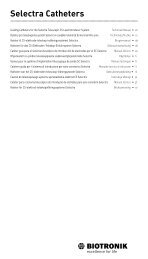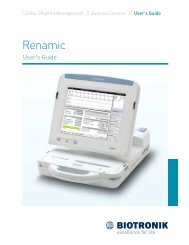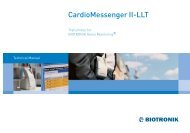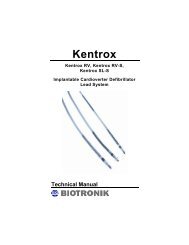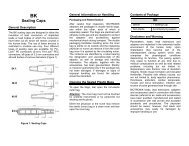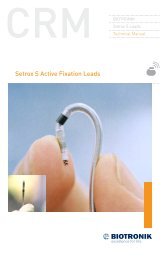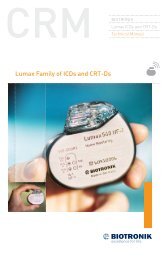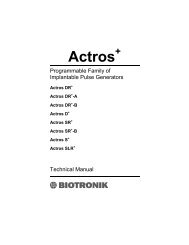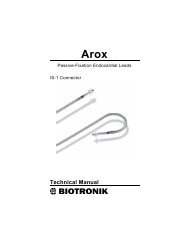Estella Pulse Generators - BIOTRONIK USA - News
Estella Pulse Generators - BIOTRONIK USA - News
Estella Pulse Generators - BIOTRONIK USA - News
You also want an ePaper? Increase the reach of your titles
YUMPU automatically turns print PDFs into web optimized ePapers that Google loves.
70 <strong>Estella</strong> <strong>Pulse</strong> <strong>Generators</strong> Technical Manual7.13 Ventricular Capture Control (VCC)7.13.1 Feature DescriptionThe VCC feature periodically measures the capture threshold, andautomatically adjusts the pacing output (with a programmable safetymargin). Additionally, the feature continuously assesses ventricularpacing capture on a beat-to-beat basis and responds to any loss ofcapture with a safety back-up pulse. During the clinical evaluation of theVentricular Capture Control algorithm, it was demonstrated that use ofVentricular Capture Control can increase device longevity (as comparedto standard programming).Differences in the signal morphology between the polarization artifactand the evoked response signal are used to distinguish capture eventsfrom non-capture events. The polarization artifact is the signal causedby the pacing pulse between the pacing electrode and the cardiac tissue.The evoked response signal is the intracardiac signal measured duringelectrical activation of the myocardium.Figure 15 shows an example of an evoked response signal and apolarization artifact. After an effective blanking period of 20 ms, thesignal is evaluated over the next 60 ms. Several characteristics of thesignal falling into this window are evaluated in order to discriminatethe evoked response (capture) from polarization artifact (possible noncapture).Figure 15: Example of a Capture and a Non-Capture beatTable 21 contains a list and description of the acronyms and termspertaining to the VCC feature used in this manual.



